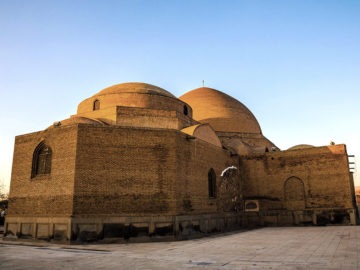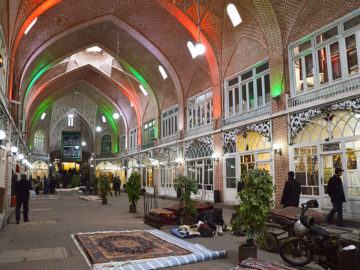Tabriz is a city in the North-West of Iran and the center of East Azerbaijan Province. It is the main center of economic activities of the region. People of Tabriz speak Azerbaijani Turkish, although according to historic texts up to the 17th century, they spoke Azari that is a branch of Persian language. Tabriz had many ups and downs in the course of history; humans and nature both damaged the city. It was many time attacked and conquered by the attackers, and many times destroyed in the destructive earthquake.
The etymologists consider different roots for the word Tabriz. It might have been Tebriz that is the Arabized version of the Pahlavi word Tavrij which is a proof of the city’s ancient history. The name refers to the volcanic activity of Sahand Mountain that is accompanied by heat. Other pronunciations of the word include Tavrej or Tavresh. In the current form, Tabriz is made of two parts, Tab meaning fever and Riz meaning to flow. Together they can mean something that makes the heat flow, probably referring to the hot water spring. The city was also called Tavri meaning spring, the word still used by the Qanbar Abad Villagers to refer to Tabriz.
The history of Tabriz dates back to Parthian or Sassanid time. The city has been the capital of Iran in eight dynasties, and the residence of crown prince in one dynasty. The prime time of the city is the Ilkhanid time. In Qajar time, it is revived especially because the crown princes of Qajar kings were sent here to live and learn the ways of ruling.
After the invasion of Arabs, a group of them remained to live here. With the economic advancement, the city became more and more important. When in 9th century a catastrophic earthquake shook the city, the city was important enough for caliph to order its immediate reconstruction. The time of prosperity doesn’t last long, and once again the earthquake destroys it.
The Mongols attack and the natural disasters weakened the city. However, when the Mongols decided to remain in country after their second invasion, the city experienced its boom. The Ilkhans chose Tabriz as their capital, and with the counsel of Iranian ministers, the city became one of the most thriving cities of the country. Tabriz continued its grandeur in the following dynasties.
In Safavid time, Tabriz was still Iran’s capital, but proximity to Ottomans land made it vulnerable. The city was conquered by ottomans numerous times, and then taken back by the Iranian troops. By the time the capital was moved to Qazvin, Tabriz already lost around 200 thousands of its residents. By the end of the 18th century, Tabriz has become a deserted city. With Qajars choosing it as the place where the crown prince lived and ruled to be ready for ruling the whole country, the city revives and is once again popular. The Iran – Russia wars, however, made it a target of Russians, and the city fell to the hands of Russians. With the peace treaty being signed, the city of Tabriz was returned to Iran. In the peace that followed, and with the ruling of Abbas Mirza, the crown prince, the city started developing.
Tabriz was crucial in the Constitutional Revolution. Even when the activities in Tehran were suppressed, Tabriz didn’t pull back and kept the ground. If it wasn’t for the Tabrizi revolutionists going to Tehran, then perhaps the Constitutional Revolution wouldn’t take place.
In a coup that took place in 1920s, Reza Khan took the control of the country. Following the coup, the country fell into chaos, and a general of army in Tabriz claimed independence of the area which was quickly suppressed by the Reza Khan troops. With Communism in Russia, and the closing of borders, the economics of Iran, especially Tabriz was seriously damaged.
In Iran – Iraq war, like the rest of the western part of the country, Tabriz was influenced and damaged. The reconstructions immediately began after the war was over, and Tabriz became a metropolis in the years that followed. The highlights of the city’s attractions are Tabriz Citadel, Kaboud Mosque, Einali Mosque, Shah Goli or Ill Gulu, and the City Hall building.





